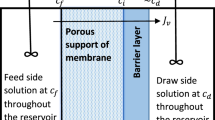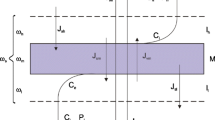Abstract
Numerically modeling only part of the reverse osmosis channel and assuming that the concentration gradient is zero at the outflow is common practice. In the present work, the effect of this hypothesis on concentration polarization and its validity are numerically investigated. The reverse osmosis system considered consists of two parallel walls. The top wall is assumed to be impermeable and a membrane is placed at the bottom wall. To investigate the hypothesis of zero concentration gradient at the outflow, two different cases are considered. In the first case, the membrane occupies the full-bottom wall, while in the second case, the membrane is followed by an impermeable wall section to ensure a steady-state concentration at the channel outlet. The finite volume method is used to solve the governing equations. In order to check the accuracy of our computational code, the simulated results for the first case without an impermeable section are validated against numerical simulations available in the literature. The simulation results show that the choice of the boundary condition at the outlet channel considered by most authors is not always obvious. This assumption leads to an under-evaluation of the membrane concentration. The deviation reaches 20% for short membrane lengths and low feed concentrations.










Similar content being viewed by others
Abbreviations
- Re :
-
Reynolds number
- CP:
-
Concentration polarization
- RO:
-
Reverse osmosis
- H :
-
Distance between walls (mm)
- L m :
-
Membrane length (mm)
- L out :
-
Final impermeable length (mm)
- U :
-
Horizontal fluid velocity (m/s)
- V :
-
Vertical fluid velocity (m/s)
- C :
-
Solute concentration (g/L)
- V w :
-
Liquid velocity through the membrane (m/s)
- U in :
-
Horizontal fluid velocity at the input (m/s)
- V in :
-
Vertical fluid velocity at the input (m/s)
- C 0 :
-
Inlet concentration (g/L)
- D :
-
Diffusivity (m2/s)
- A :
-
Membrane permeation, A (m/Pa s)
- P out :
-
Output pressure (bar)
- C p :
-
Permeate concentration (g/L)
- C m :
-
Wall concentration (g/L)
- x, y :
-
Cartesian coordinates (mm)
- P :
-
Working pressure (bar)
- μ :
-
Fluid viscosity, \(\mu\) (Pa/s)
- ρ :
-
Fluid density, \(\rho\) (g/L)
- π :
-
Osmotic pressure (atm)
- Δπ :
-
Osmotic transmembrane pressure (atm)
- ΔP :
-
Transmembrane pressure (bar)
References
Schwinge J, Neal PR, Wiley DE et al (2004) Spiral wound modules and spacers. J Membr Sci 242(1–2):129–153. https://doi.org/10.1016/j.memsci.2003.09.031
Jogdand A, Chaudhuri A (2015) Modeling of concentration polarization and permeate flux variation in a roto-dynamic reverse osmosis filtration system. Desalination 375:54–70. https://doi.org/10.1016/j.desal.2015.07.011
Geraldes V, Semiao V, Norberta de Pinho M (2002) The effect on mass transfer of momentum and concentration boundary layers at the entrance region of a slit with a nanofiltration membrane wall. Chem Eng Sci 57(5):735–748. https://doi.org/10.1016/s0009-2509(01)00441-9
Salcedo-Díaz R, García-Algado P, García-Rodríguez M et al (2014) Visualization and modeling of the polarization layer in crossflow reverse osmosis in a slit-type channel. J Membr Sci 456:21–30. https://doi.org/10.1016/j.memsci.2014.01.019
Alexiadis A, Wiley DE, Vishnoi A et al (2007) CFD modelling of reverse osmosis membrane flow and validation with experimental results. Desalination 217(1–3):242–250. https://doi.org/10.1016/j.desal.2007.02.014
Ahmad AL, Lau KK, Bakar MA et al (2005) Integrated CFD simulation of concentration polarization in narrow membrane channel. Comput Chem Eng 29(10):2087–2095. https://doi.org/10.1016/j.compchemeng.2005.06.001
Ma S, Song L, Ong S et al (2004) A 2-D streamline upwind Petrov/Galerkin finite element model for concentration polarization in spiral wound reverse osmosis modules. J Membr Sci 244(1–2):129–139
Ahmad AL, Lau KK, Abu Bakar MZ (2005) Impact of different spacer filament geometries on concentration polarization control in narrow membrane channel. J Membr Sci 262(1–2):138–152. https://doi.org/10.1016/j.memsci.2005.06.056
Ahmad AL, Lau KK (2006) Impact of different spacer filaments geometries on 2D unsteady hydrodynamics and concentration polarization in spiral wound membrane channel. J Membr Sci 286(1–2):77–92. https://doi.org/10.1016/j.memsci.2006.09.018
Al-Obaidi MA, Mujtaba IM (2016) Steady state and dynamic modeling of spiral wound wastewater reverse osmosis process. Comput Chem Eng 90:278–299. https://doi.org/10.1016/j.compchemeng.2016.04.001
Gruber MF, Johnson CJ, Tang CY et al (2011) Computational fluid dynamics simulations of flow and concentration polarization in forward osmosis membrane systems. J Membr Sci 379(1–2):488–495. https://doi.org/10.1016/j.memsci.2011.06.022
Asadi Tashvigh A, Fouladitajar A, Zokaee Ashtiani F (2015) Modeling concentration polarization in crossflow microfiltration of oil-in-water emulsion using shear-induced diffusion; CFD and experimental studies. Desalination 357:225–232. https://doi.org/10.1016/j.desal.2014.12.001
Geraldes V, Semião V, Norberta Pinho M (2003) Hydrodynamics and concentration polarization in NF/RO spiral-wound modules with ladder-type spacers. Desalination 157(1–3):395–402. https://doi.org/10.1016/s0011-9164(03)00422-3
Geraldes V, Semiao V, Norberta de Pinho M (2004) Concentration polarisation and flow structure within nanofiltration spiral-wound modules with ladder-type spacers. Comput Struct 82(17–19):1561–1568. https://doi.org/10.1016/j.compstruc.2004.03.052
Miranda JM, Campos JBLM (2001) An improved numerical scheme to study mass transfer over a separation membrane. J Membr Sci 188(1):49–59. https://doi.org/10.1016/s0376-7388(01)00360-x
de Pinho MN, Semião V, Geraldes V (2002) Integrated modeling of transport processes in fluid/nanofiltration membrane systems. J Membr Sci 206(1–2):189–200
Singh R, Laurence RL (1979) Influence of slip velocity at a membrane surface on ultrafiltration performance—I. Channel flow system. Int J Heat Mass Transf 22(5):721–729
Patankar SV (1980) Numerical heat transfer and fluid flow. Hemisphere Publishing Corporation, New York
Versteeg HK, Malalasekera W (2007) An introduction to computational fluid dynamics: the finite volume method, 2nd edn. Pearson Education Limited, London
Aouanouk SA, Mouheb A, Absi R et al (2017) The behavior of ß-lactoglobulin protein in plate heat exchanger’s channel during milk heat treatment. Acta Aliment 46(4):411–419. https://doi.org/10.1556/066.2017.0002
Lawrence N (2002) Compaq Visual Fortran: a guide to creating windows applications. Digital Press, Boston
Rohlfs W, Thiel GP, Lienhard VJH (2016) Modeling reverse osmosis element design using superposition and an analogy to convective heat transfer. J Membr Sci 512:38–49. https://doi.org/10.1016/j.memsci.2016.03.049
Radu AI, Vrouwenvelder JS, van Loosdrecht MCM et al (2010) Modeling the effect of biofilm formation on reverse osmosis performance: flux, feed channel pressure drop and solute passage. J Membr Sci 365(1–2):1–15. https://doi.org/10.1016/j.memsci.2010.07.036
Miranda JM, Campos JBLM (2007) Numerical study of a hybrid membrane cell with semi and fully permeable membrane sub-sections. Chem Eng Sci 62(4):1215–1229. https://doi.org/10.1016/j.ces.2006.11.001
Su X, Li W, Palazzolo A et al (2018) Concentration polarization and permeate flux variation in a vibration enhanced reverse osmosis membrane module. Desalination 433(January):75–88
Afonso A, Miranda JM, Campos JBLM (2009) Numerical study of BSA ultrafiltration in the limiting flux regime: effect of variable physical properties. Desalination 249(3):1139–1150. https://doi.org/10.1016/j.desal.2009.05.012
Park J, Lee KS (2017) A two-dimensional model for the spiral wound reverse osmosis membrane module. Desalination 416(December 2016):157–165. https://doi.org/10.1016/j.desal.2017.05.006
Kavianipour O, Ingram GD, Vuthaluru HB (2017) Investigation into the effectiveness of feed spacer configurations for reverse osmosis membrane modules using Computational Fluid Dynamics. J Membr Sci 526(December 2016):156–171. https://doi.org/10.1016/j.memsci.2016.12.034
Bucs SS, Linares RV, Vrouwenvelder JS (2016) Biofouling in forward osmosis systems: an experimental and numerical study. Water Res. https://doi.org/10.1016/j.watres.2016.09.031
Ishigami T, Matsuyama H (2015) Numerical modeling of concentration polarization in spacer-filled channel with permeation across reverse osmosis membrane. Ind Eng Chem Res 54(5):1665–1674. https://doi.org/10.1021/ie5039665
Lim SY, Liang YY, Fimbres Weihs GA et al (2018) A CFD study on the effect of membrane permeance on permeate flux enhancement generated by unsteady slip velocity. J Membr Sci 556:138–145. https://doi.org/10.1016/j.memsci.2018.03.070
Amokrane M, Sadaoui D, Koutsou CP et al (2015) A study of flow field and concentration polarization evolution in membrane channels with two-dimensional spacers during water desalination. J Membr Sci 477:139–150. https://doi.org/10.1016/j.memsci.2014.11.029
Ramon GZ, T N, Hoek EMV (2013) Osmosis-assisted cleaning of organic-fouled seawater RO membranes. Chem Eng J 218:173–182. https://doi.org/10.1016/j.cej.2012.12.006
Wiley DE (2003) Techniques for computational fluid dynamics modelling of flow in membrane channels. J Membr Sci 211:127–137
Author information
Authors and Affiliations
Corresponding author
Additional information
Technical Editor: Jader Barbosa Jr., Ph.D.
Rights and permissions
About this article
Cite this article
Hamdache, A., Belkacem, M. Effects of a zero normal-concentration-gradient outflow boundary condition on concentration polarization in a CFD study of a reverse osmosis process. J Braz. Soc. Mech. Sci. Eng. 40, 507 (2018). https://doi.org/10.1007/s40430-018-1430-z
Received:
Accepted:
Published:
DOI: https://doi.org/10.1007/s40430-018-1430-z




